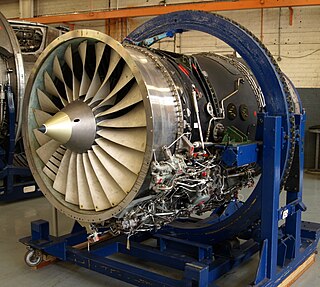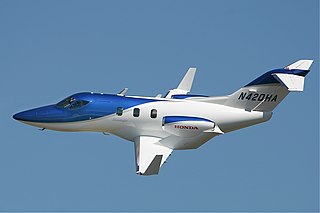
The Pratt & Whitney JT9D engine was the first high bypass ratio jet engine to power a wide-body airliner. Its initial application was the Boeing 747-100, the original "Jumbo Jet". It was Pratt & Whitney's first high-bypass-ratio turbofan.

The Engine Alliance GP7000 is a turbofan jet engine manufactured by Engine Alliance, a joint venture between General Electric and Pratt & Whitney. It is one of the powerplant options available for the Airbus A380, along with the Rolls-Royce Trent 900.

The Rolls-Royce RB.183 Tay is a medium-bypass turbofan engine, developed from the RB.183 Mk 555 Spey core and using a fan scaled directly from the Rolls-Royce RB.211-535E4 to produce versions with a bypass ratio of 3.1:1 or greater. The IP compressor and LP turbine were designed using technology from the RB.211 programme. The engine was first run in August 1984. The Tay 650 had a new HP turbine which incorporated new technology which had been proven with the RB.211-535E4. This engine also had a new combustor for improved durability. The Tay family is used on a number of airliners and larger business jets, including the Gulfstream IV family, Fokker 70 and Fokker 100, with a later version being used to re-engine Boeing 727-100s.

The PowerJet SaM146 is a turbofan engine produced by the PowerJet joint venture between Snecma (Safran) of France and NPO Saturn of Russia. Developing 68–80 kN (15,000–18,000 lbf) of thrust, the SaM146 is used on the Sukhoi Superjet 100.

The Honda HA-420 HondaJet is a light business jet produced by the Honda Aircraft Company of Greensboro, North Carolina, United States. Original concepts of the aircraft started in 1997 and were completed in 1999. It took its maiden flight on December 3, 2003, received its FAA type certificate in December 2015, and was first delivered that same month. By the end of 2021, 200 jets had been delivered.

The Rolls-Royce Trent 500 is a high-bypass turbofan produced by Rolls-Royce to power the larger A340-500/600 variants. It was selected in June 1997, first ran in May 1999, first flew in June 2000, and achieved certification on 15 December 2000. It entered service in July 2002 and 524 engines were delivered on-wing until the A340 production ended in 2012.

The Rolls-Royce Trent 800 is a high-bypass turbofan produced by Rolls-Royce plc, one of the engine options for the early Boeing 777 variants. Launched in September 1991, it first ran in September 1993, was granted EASA certification on 27 January 1995, and entered service in 1996. It reached a 40% market share, ahead of the competing PW4000 and GE90, and the last Trent 800-powered 777 was delivered in 2010. The Trent 800 has the Trent family three shaft architecture, with a 280 cm (110 in) fan. With a 6.4:1 bypass ratio and an overall pressure ratio reaching 40.7:1, it generates up to 413.4 kN of thrust.

The General Electric TF34 is an American military turbofan engine used on the A-10 Thunderbolt II, S-3 Viking and RQ-170 Sentinel.

The Williams FJ44 is a family of small, two-spool, turbofan engines produced by Williams International for the light business jet market. Until the recent boom in the very light jet market, the FJ44 was one of the smallest turbofans available for civilian applications. Although basically a Williams design, Rolls-Royce was brought into the project at an early stage to design, develop, and manufacture an air-cooled high-pressure (HP) turbine for the engine. The FJ44 first flew on July 12, 1988 on the Scaled Composites/Beechcraft Triumph aircraft.
The General Electric F118 is a non-afterburning turbofan engine produced by GE Aviation, and is derived from the General Electric F110 afterburning turbofan.

The Pratt & Whitney Canada JT15D is a small turbofan engine built by Pratt & Whitney Canada. It was introduced in 1971 at 2,200 lbf (9,800 N) thrust, and has since undergone a series of upgrades to just over 3,000 lbf (13 kN) thrust in the latest versions. It is the primary powerplant for a wide variety of smaller jet aircraft, notably business jets.

The Pratt & Whitney Canada PW300 series is a family of turbofan jet engines developed by Pratt & Whitney Canada specifically for business jet applications.

The Garrett TFE731 is a family of geared turbofan engines commonly used on business jet aircraft. Garrett AiResearch originally designed and built the engine, which due to mergers was later produced by AlliedSignal and now Honeywell Aerospace.

The CFE CFE738 is a small turbofan engine aimed at the business/commuter jet market manufactured by the CFE Company, and is used on the Dassault Falcon 2000.

The Safran Silvercrest is a French turbofan under development by Safran Aircraft Engines.

The Honeywell HTF7000 is a turbofan engine produced by Honeywell Aerospace. Rated in the 6,540–7,624 lbf (29.09–33.91 kN) range, the HTF7000 is used on the Bombardier Challenger 300/350, Gulfstream G280, Embraer Legacy 500/450 and the Cessna Citation Longitude. Its architecture could be extended for a range of 8,000 to 10,000 lbf thrust.
The Turbomeca Astafan is a single-spool, variable-pitch turbofan engine developed from the Turbomeca Astazou. Despite successful flight-testing, an efficient, quiet and clean design and some commercial interest, the Astafan never entered series production. The engines were only flown on the Fouga 90 prototype and Turbomeca's two test aircraft.

The Pratt & Whitney Canada PW800 is a series of turbofan engines in the 10,000–20,000 lbf (44–89 kN) thrust class, manufactured by Pratt & Whitney Canada. Intended for the regional jet and business jet market, the gear-less PW800 shares a common core with the larger, geared PW1000G. The first variants were certified on February 15, 2015, to power the new Gulfstream G500/G600. After that it has been certified also for the Dassault Falcon 6X in 2021.

The General Electric Passport is a turbofan developed by GE Aerospace for large business jets. It was selected in 2010 to power the Bombardier Global 7500 and 8000, first run on June 24, 2013, and first flown in 2015. It was certified in April 2016 and powered the Global 7500 first flight on November 4, 2016, before its 2018 introduction. It produces 14,000 to 20,000 lbf of thrust, a range previously covered by the General Electric CF34. A smaller scaled CFM LEAP, it is a twin-spool axial engine with a 5.6:1 bypass ratio and a 45:1 overall pressure ratio and is noted for its large one-piece 52 in (130 cm) fan 18-blade titanium blisk.

The General Electric Affinity was a turbofan developed by GE Aviation for supersonic transports. Conceived in May 2017 to power the Aerion AS2 supersonic business jet, initial design was completed in 2018 and detailed design in 2020 for the first prototype production. GE Aviation discontinued development of the engine in May 2021. Its high-pressure core is derived from the CFM56, matched to a new twin fan low-pressure section for a reduced bypass ratio better suited to supersonic flight.



















